|
|
| |
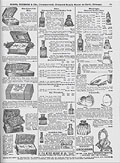 |
|
| |
 Writing
instruments, one of seven pages of writing instruments in the Sears,
Roebuck & Co. Catalogue, 1897. Writing
instruments, one of seven pages of writing instruments in the Sears,
Roebuck & Co. Catalogue, 1897.
|
|
| |
|
|
|
Writing Instruments and Stationery
by Bianca
Gendreau
Mail-order catalogues are a unique source of
information on
the writing instruments and stationery available between 1880 and 1940.
Since letter writing is above all an intellectual act and engages both the
mind
and the senses, writers must surround themselves with objects and
instruments
to express their thoughts, even if it is only with a bit of paper and a
pen.
Introduction |
Catalogues for Letter Writers | Putting
Pen to Paper | A World of Paper | Further Reading
| |
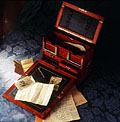 |
|
| |
 Travel
writing case containing writing paper, sealing wax, seals, an inkwell,
and fountain pens, late 19th century. Travel
writing case containing writing paper, sealing wax, seals, an inkwell,
and fountain pens, late 19th century.
|
|
| |
|
|
|
|
| |
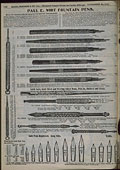 |
|
| |
 Fountain
pens and penholders, 1900, Sears, Roebuck & Co. (Chicago) Fall Catalogue,
1900, p. 142. These models illustrate the diversity and aesthetic
qualities of the writing instruments available at the time. Fountain
pens and penholders, 1900, Sears, Roebuck & Co. (Chicago) Fall Catalogue,
1900, p. 142. These models illustrate the diversity and aesthetic
qualities of the writing instruments available at the time.
|
|
| |
|
|
|
|
| |
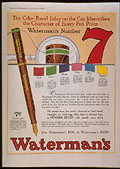 |
|
| |
 Ad
for a Waterman fountain pen, 1928, Maclean's, September 15, 1928. Ad
for a Waterman fountain pen, 1928, Maclean's, September 15, 1928.
|
|
| |
|
|
|
|
|
Introduction
What writing instruments were available in Canada between 1880 and 1940?
Where
and how could they be obtained? Lovell's Montreal Directory for
1880-1881
(Montreal, John Lovell & Son) mentions shops in major urban centres
that
specialized in the sale of writing instruments. According to the
directory, writing
instruments could be purchased at "Booksellers and
Stationers," who
placed ads in various Canadian periodicals to promote their products. Such
directories
provided an overview of the market in a particular city. Outside the major
centres,
people relied on the mail-order catalogues they received by post.
Catalogues for Letter Writers
Starting in the late 19th century, a wide range of writing instruments
could
be ordered from three types of mail-order catalogues: specialized
writing-instrument
and stationery catalogues; catalogues published by jewellers, goldsmiths,
or
silversmiths; and mail-order catalogues that featured a variety of
merchandise.
| |
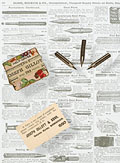 |
|
| |
 Box
of pen nibs, made in England by Joseph Gillott & Sons and featured in
the Sears, Roebuck & Co. Catalogue, 1897. Box
of pen nibs, made in England by Joseph Gillott & Sons and featured in
the Sears, Roebuck & Co. Catalogue, 1897.
|
|
| |
|
|
|
Catalogues of writing instruments were published by wholesalers for the
retail
market, but some were also made available to the general public. They were
very
elaborate (see J. C. Wilson & Co. Limited, 1908) and featured a large
assortment
of writing instruments - 21 models of pen nibs and 14 models of
penholders.
The United Typewriter Company Limited published a catalogue from 1913 to
1922
and it offered an even greater selection, including inkwells, bottles of
ink,
and a wide range of desk accessories. The first page of the catalogue had
photographs
of the company's salesrooms and customers were informed that the
company's
products were available in over fifteen stores in major Canadian cities,
from
Halifax to Victoria. The catalogues also had a whole assortment of writing
paper.
It should be noted that certain products made by particular companies,
such as
Easterbrook and Gillott pen nibs, were found in both specialized and
general
catalogues. The only difference was the price per unit. Prices were
generally
higher in specialized catalogues.
Jewellers' catalogues offered luxury writing instruments. The
catalogue
published in 1923 by Ryrie Bros. Limited, a Toronto company, featured
products
that were distinctive not only because of their design and the materials
used,
but also because of the way they were made. It included silver and gold
fountain
pens and pencils, which not everyone could afford. There was, however, a
Waterman
fountain pen at a price similar to those in other mail-order catalogues.
Jewellers'
catalogues also offered stationery, but in gift sets. Such publications
were
meant for a limited clientele, but the companies that produced them tried
to
reach a wider market by promoting the COD service introduced by the Post
Office
department on October 1, 1922. A full-page ad at the beginning of the
Ryrie catalogue
- "C.O.D. postal delivery, an added convenience to shopping by
mail"
- highlights the advantages of shopping by mail.
Department store catalogues sold writing instruments and a wide
selection
of other products, including household goods, tools, clothing, sporting
goods,
and prefabricated homes. In addition to promoting fashion and new
products, they
allowed new "consumers" to buy quality goods at reasonable
prices
without fluctuations in availability. One of the first Eaton's
catalogues
contained only a list of articles and their prices. Soon, however,
catalogues
increased in volume and were illustrated with detailed drawings. The
categories
of items offered also became increasingly varied. In catalogues such as
Eaton's,
Woodward's, Simpson's, Dupuis Frères, and Sears,
Roebuck &
Co., writing instruments were in the stationery section. All catalogues
published
between 1888 and 1940 seem to have had a section that featured stationery
and
writing accessories.
| |
 |
|
Stamp cases, 1897. Stamp
cases
were introduced in the 1840s, when the first postage stamp was issued,
but their golden age was in the 1890s. The advent of stamp booklets and
vending machines played a role in the gradual disappearance of these
decorative boxes. There were desktop models and portable models such
as these ones from the Canadian Postal Museum and Sears, Roebuck & Co.
Catalogue, 1897 (reproduction). Courtesy of Sears Roebuck and Co.
|
 |
|
|
Putting Pen to Paper
| |
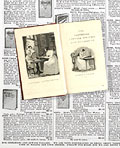 |
|
| |
 Letter
writing required specific skills and knowledge of certain rules. Short
manuals were available to help letter writers who lacked inspiration.
The Universal Letter Writer by Reverend T. Cooke was published in 1853
and is similar to those sold in the Sears, Roebuck & Co. Catalogue, 1897.
Courtesy of Sears Roebuck and Co. Letter
writing required specific skills and knowledge of certain rules. Short
manuals were available to help letter writers who lacked inspiration.
The Universal Letter Writer by Reverend T. Cooke was published in 1853
and is similar to those sold in the Sears, Roebuck & Co. Catalogue, 1897.
Courtesy of Sears Roebuck and Co.
|
|
| |
|
|
|
As essential as the pen, writing paper reflects a style, an era, a
milieu,
and a trend. Catalogues sold different types of paper for various
circumstances.
In those published in the 1890s (Sears, Roebuck 1897; Eaton's,
Fall/Winter
1888-1889), paper was sold by the quire, the unit of measure used to
determine
the weight of a package of paper. According to the catalogues, the sheets
were
always about 5 x 7 inches (13 x 18 cm). Only one side was to be written on
and
the sheet was to be folded in half lengthwise afterwards. However, despite
the
advice in letter-writing manuals that were meant to guide writers in their
choice
of words and in the presentation of letters, people cut sheets or wrote on
both
sides of the page so as not to waste paper.
According to the manuals, the colour of the writing paper was very
important.
Letters were to be written only on cream-coloured paper. Coloured paper
supposedly
lacked distinction, but it was widely used in personal correspondence and
was
found in numerous catalogues. In 1927, Eaton's introduced tangerine,
a
colour that displaced the more traditional pink, blue, and grey papers
that were
offered in the 1901-1902 catalogues.
| |
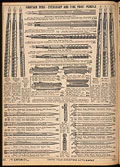 |
|
| |
 Fountain
pens and pencils to wear on chains, Eaton's Fall Catalogue, 1924-1925,
p. 324. Fountain
pens and pencils to wear on chains, Eaton's Fall Catalogue, 1924-1925,
p. 324.
|
|
| |
|
|
|
The variety of writing instruments found in
catalogues
provides an indication of the range of objects needed to write a letter.
Eaton's
Winter 1925 and Spring/Summer 1927 catalogues featured all categories of
instruments:
penholders, fountain pens, pencils, paper cutters, bottles of ink, and
inkwells.
These two catalogues also offered several fountain pens and pencils made
of luxury
materials (gold, silver, or mother-of-pearl).
Starting in the 1920s, some catalogues, such as Eaton's
1923-1924,
targeted women in their promotion of writing instruments. There were
Waterman's
Pens for Women, Waterman's Women's Chatelaine Style Pen (a
fountain
pen with a ring that could be attached to a chain), and Women's
Eversharp
Pencils. Eversharp was one of the many types of mechanical pencils
available
(men's models had a clip, women's had a ring). That was the
first
time the use of a ring was clearly associated with women. Before that,
rings
were promoted as a means of hanging the pencil from a watch chain.
The type of writing instruments sold in catalogues changed as
technology and
writing practices evolved. When the fountain pen was introduced, the
ceremony
of writing, which required patience and skill, was reduced to a common
practice
that was easy and risk-free. The tools needed for writing (inkwell, pen
wiper,
and penholder) disappeared. The First World War marked a turning point in
the
market as fountain pens improved in quality. The volume of mail exchanged
between
soldiers and their families increased. Eaton's 1918 catalogue
featured
The Soldier's Pen, a Waterman Ideal Safety Pen (fountain pen) that
was
specially designed for clean, leak-free writing.
A vast market opened up after 1918. The first pens made of coloured
plastic
appeared, but that did not rule out gold and silver plating. Fountain pens
remained
extremely popular until the 1940s, when the ballpoint pen was introduced.
| |
 |
|
Waterman fountain
pen-and-pencil
set, 1934. Fountain pens made of coloured plastic were introduced after
the First World War, but that did not exclude gold and silver plating.
This set was featured in Dupuis Frères Spring/Summer Catalogue,
1934.
|
 |
|
|
A World of Paper
Over time, stationery changed more than writing instruments. There were
three
types of changes. First, there was a change in the quality and thickness
of the
writing paper sold. It seems to have become uniform, so that only one
quality
was sold in catalogues. However, that quality seems to have been more in
keeping
with the real needs of letter writers. The social status that had long
been associated
with the choice of writing paper seems to have become less and less
evident.
According to letter-writing manuals, the paper used was a clear indication
of
status so it had to be chosen carefully. However, mail-order catalogues,
which
reached a very large percentage of the population in rural areas, made no
distinction
when it came to paper.
The second change that becomes apparent when looking at catalogues is
the
way writing paper was sold. In catalogues published in the late 19th
century,
paper was sold only by the quire, with a set number of sheets (25).
Envelopes
were sold separately. All that changed. Stationery sets with matching
envelopes
and paper appeared. The number of sheets included in such sets varied and
that
had an impact on the price of writing paper. Boxes for storing writing
paper
were also sold through catalogues. They were similar to the wooden writing
cases
of the 19th century but were not used as a writing surface. Since they
cost less
than writing cases, more people could afford them.
The variety of paper available also became more limited. That was the
third
change. Calling cards and mourning paper gave way to greeting cards for
various
occasions that were pre-printed by the manufacturer. Companies that
produced
mail-order catalogues knew how to cater to the new tastes and needs of the
population
by offering a range of products that kept up with the trends.
|
Further Reading
Dauphin, Cécile. Prête-moi ta plume: Les manuels
épistolaires
au XIXe siècle. Paris: Éditions Kimé, 2000.
De Biasi, Pierre-Marc and Karine Douplitzky. La saga du
papier. Paris:
Adam Biro / Arte Éditions, 2002.
Gendreau, Bianca. "L'art d'écrire au Canada
entre
1870 et 1940." Research report, Canadian Postal Museum, 1999.
Le Collen, Éric. Objets d'écriture. Paris:
Flammarion,
1998.
Marshall, Jim. Pens & Writing Equipment: A Collector's
Guide.
London: Miller's, 1999.
|
| |
|
|